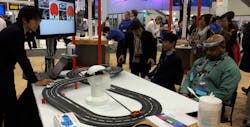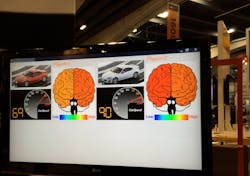Can you control objects with your brain? Visitors to the Hamamatsu Photonics booth during SPIE Photonics West 2015 could—and did, with a little help from a system based on near-infrared spectroscopy (NIRS).
Hamamatsu's display included the Brain Machine Interface: a double-track toy car racing game setup that challenged pairs of participants to square off. The "racers" each donned an electronic headband, incorporating a NIRS optical probe, able to wirelessly send signals to one of the cars on the track (see Fig. 1). Consisting of an emitter and detector, the probe monitors absorption of IR light in cerebral tissue. The headband positions the probe over the left prefrontal lobe, keeping extraneous light out and transmitted NIR light in. Optical densities from three continuous wavelengths of NIR light (735, 810, and 850 nm) indicate changes in tissue oxyhemoglobin and deoxyhemoglobin over time.
By concentrating on the car—red or white—for which s/he was responsible, each driver was able to increase the vehicle's speed. Race fans could not only watch how fast the cars zoomed around the track, they could also see real-time changes in blood oxygenation in the participants' brains, as represented by color in side-by-side brain diagrams (each with a corresponding with speedometer) on a large computer monitor. A brain diagram heavy on cool colors (blue or green) indicated that the participant's brain—and car—was at rest, while a representation with orange or red indicated concentration corresponding to greater oxygenation-and speed (see Fig. 2). In effect, the display showed the change in concentration of oxygenated hemoglobin (ΔO2Hb) and deoxygenated hemoglobin (ΔHHb).Besides mind-controlled car racing, the technology behind the game has some practical biomedical applications, including patient monitoring in hospitals; management of tissue oxygenation during surgery; and clinical studies relation to brain function, brain metabolism, and muscle function.


